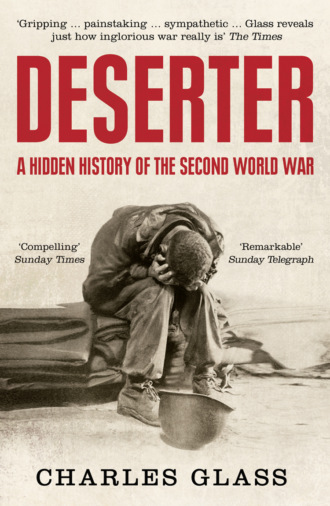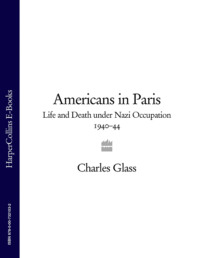
Полная версия
Deserter: The Last Untold Story of the Second World War


Dedication
To two friends, brave American soldiers,
Private First Class Stephen J. Weiss
and the late Colonel Alfred E. Baker
During the Second World War, the United States awarded Private Weiss the Bronze Star, three US battle stars, the Second World War Victory Medal, Southern France D-Day Landing Citation, Combat Infantry Badge and Good Conduct Medal. France named him Officier of the Légion d’honneur and gave him two Croix de Guerre, the Médaille de la Résistance, the Croix du Combatant, the Vosges Department Citizen of Honour Diploma and French citizenship.
During the Vietnam War, the United States awarded Colonel Baker, as the Pennsylvania House of Representatives noted in his honour, ‘the Silver Star for gallantry in action, multiple awards of the Defense Superior Service Medal, multiple awards of the Legion of Merit, three awards of the Bronze Star, three awards of the Meritorious Service Medal, four awards of the Purple Heart medal (for wounds received in battle) and many other service and achievement medals’. At one time, he was the most highly decorated veteran of the Vietnam War era.
Epigraph
I lack the guts to take being thought a coward.
Audie Murphy, To Hell and Back (Henry Holt, 1949)
CONTENTS
Cover
Title Page
Dedication
Epigraph
Introduction
BOOK I: Boys to Soldiers
ONE
TWO
THREE
FOUR
FIVE
SIX
SEVEN
EIGHT
NINE
TEN
ELEVEN
TWELVE
THIRTEEN
FOURTEEN
FIFTEEN
SIXTEEN
BOOK II: Soldiers to Deserters
SEVENTEEN
EIGHTEEN
NINETEEN
TWENTY
TWENTY-ONE
TWENTY-TWO
TWENTY-THREE
TWENTY-FOUR
BOOK III: Military Justice
TWENTY-FIVE
TWENTY-SIX
TWENTY-SEVEN
TWENTY-EIGHT
TWENTY-NINE
THIRTY
THIRTY-ONE
THIRTY-TWO
Epilogue
Acknowledgements
Notes
Bibliography
Picture Section
About the Author
By the Same Author
Copyright
About the Publisher
INTRODUCTION
BY HIS OWN ADMISSION, Eddie Slovik was the unluckiest man alive. Nearly 50,000 American and 100,000 British soldiers deserted from the armed forces during the Second World War, but the twenty-five-year-old ex-convict from Detroit, Michigan, was the only one executed for it. Slovik’s desertion in northern France on 9 October 1944 was atypical in that, while 80 per cent of deserters were frontline infantrymen escaping after long periods of continuous combat, he never fought a battle. Nor did he go on the run as most other deserters did. His mistake was to make clear that he preferred prison to battle. Rather than grant his wish, a court martial condemned him, in accordance with the Articles of War that then prescribed the forms of military justice, to ‘death by musketry’.
Of the forty-nine Americans sentenced to death for desertion during the Second World War, Slovik was the only one whose appeal for commutation was rejected. The timing of his court martial, amid the November fighting in the Hürtgen Forest that caused 6,184 casualties among the 15,000 troops in Slovik’s 28th Infantry Division, militated against clemency. So too did the coincidence in January 1945 of his appeal against the death sentence and the German counter-offensive known as the Battle of the Bulge, when the US Army in northern Europe was fighting for its own survival. It was not the moment for the Supreme Allied Commander, General Dwight Eisenhower, to be seen to condone desertion.
Correspondence among senior commanders documents their belief that Slovik’s death was necessary to prevent others from following his example. They nonetheless decreed that his execution in the remote French village of Sainte-Marie-aux-Mines be conducted in secrecy. (Slovik, the condemned ‘coward’, died without pleading for his life or showing anything other than courage before the firing squad.) Even if soldiers at the front had known that the young private was shot for desertion on the morning of 31 January 1945, the Battle of the Bulge had by then ended in an Allied victory. The urgency for lethal deterrence had disappeared, as the Allied armies resumed the offensive that would topple the Third Reich four months later. Concealing the truth about Slovik’s execution extended to informing his wife Antoinette only that he had died in the European Theater of Operations.
Journalist and novelist William Bradford Huie uncovered the cause of Slovik’s death in 1948, but the issue remained so sensitive that he concealed the condemned man’s identity in Liberty magazine as ‘a twenty-five year old American white man – call him Lewis Simpson – a replacement in the 28th Division’. Huie’s article raised fundamental questions about why only one deserter among thousands was put to death. It also cast doubt on the willingness of Americans to fight. Huie, who served in the United States Navy during the war, noted that psychiatrists had permitted 1,750,000 men, one out of every eight they examined, to avoid military service for ‘reasons other than physical’. Despite the rigorous screening, soldiers suffered nervous breakdowns, mental trauma and ‘battle fatigue’ (also called ‘battle exhaustion’) that rendered them unfit for combat. Huie observed, ‘During the Second World War approximately 38,000 officers and men – about 10 per cent were officers – were tried by army general courts-martial for seeking to evade hazardous duty by some dishonorable means.’ Their sentences, apart from Slovik’s, were less onerous than the hardships suffered by their comrades who fought on. Huie considered this an outrage: ‘If a sound-bodied, sound-minded American soldier who deserts his comrades on the eve of battle deserves only comfortable detention, subsequent pardon, and a college education under the G.I. Bill of Rights, then why should any man ever again risk death in combat for this country?’
He added that ‘by “abolishing cowardice” the psychiatrists had tended to relieve all Americans of the individual responsibility to fight.’ Yet most soldiers did fight. Desertions were almost non-existent in the Pacific, where a man seeking to avoid danger had nowhere to hide. In Europe, the total that fled from the front rarely exceeded 1 per cent of manpower. However, it reached alarming proportions among the 10 per cent of the men in uniform who actually saw combat. Allied commanders debated means to staunch the flow. General George Patton wanted to shoot the ‘cowards’, and in Sicily he famously slapped a shell-shocked soldier whom he accused of malingering. Senior British commanders in North Africa and Italy pleaded with their government to restore the death penalty for desertion as in the First World War. Other commanders, whose views prevailed, favoured providing psychiatric as well as traditional medical care in forward aid stations. They recognized that the mind – subject to the daily threat of death, the concussion of aerial bombardment and high-velocity artillery, the fear of landmines and booby traps, malnutrition, appalling hygiene and lack of sleep – suffered wounds as real as the body’s. Providing shattered men with counselling, hot food, clean clothes and rest was more likely to restore them to duty than threatening them with a firing squad.
Few deserters were cowards. Many broke under the strain of constant battle, having faced the Axis enemy without let-up for months at a time. Owing to the Allies’ flawed system of replacing troops at the front, men were pushed beyond their limit. Poor leadership by undertrained junior officers, many of whom stayed back from combat, left young soldiers without inspiration to endure daily artillery barrages along often-static frontlines. High desertion rates in any company, battalion or division pointed to failures of command and logistics for which blame pointed to leaders as much as to the men who deserted. Unit cohesion was poor, as post-war studies demonstrated, because replacement soldiers were distributed individually to assorted companies and divisions rather than as bodies of men who knew and trusted one another. Some soldiers deserted when all the other members of their units had been killed and their own deaths appeared inevitable.
Those who showed the greatest sympathy to deserters were other frontline soldiers. They had, at one time or another, felt the temptation to opt out of the war through desertion, shooting themselves in the foot or lagging behind when ordered forward. It was a rare infantryman who attempted to prevent his comrades from leaving the line. The astounding fact is not that so many men deserted but that the deserters were so few.
Eddie Slovik’s identity became public knowledge in 1954, when Huie published his well-researched The Execution of Private Slovik. Twenty years later, the actor Martin Sheen played Slovik in a television film of the same title. Sheen recited the actual words that Slovik himself uttered before his execution: ‘They’re not shooting me for deserting the United States Army, thousands of guys have done that. They just need to make an example out of somebody and I’m it because I’m an ex-con. I used to steal things when I was a kid, and that’s what they are shooting me for. They’re shooting me for the bread and chewing gum I stole when I was 12 years old.’
Eddie Slovik was the first American soldier executed for desertion since a Union Army firing squad shot one William Smitz of Company F, 90th Pennsylvania Volunteers, in 1865. (More than 300,000 troops deserted from the Union and Confederate Armies in the Civil War. Mark Twain famously deserted from both sides.) Slovik was not the only soldier to desert from the American armed forces between 1865 and 1945. Desertion was common in the post-Civil War Army, when many frontier troops had a cavalier attitude towards military service. Badly paid, miserably fed and maltreated by their officers, they had few qualms about drifting away to the gold fields, silver mines and cattle drives where conditions and pay were better. No one was shot for desertion during the wars against North America’s indigenous population or the Spanish-American War. During the First World War, of the twenty-four death sentences imposed for desertion by courts martial, President Woodrow Wilson commuted them all.
If Slovik was the unluckiest deserter in the US Army, Wayne Powers was probably the most fortunate. Private First Class Wayne Powers was a twenty-three-year-old army truck driver when he landed in France three days after D-Day. In November 1944, he met a dark-haired French girl named Yvette Beleuse in the northern French village of Mont d’Origny near the Belgian border. Powers, born in Chillicothe, Missouri, spoke no French, and Yvette did not know English. As the newspaper France Soir wrote later, ‘She gave him a woman’s smile after months of murderous combat.’ When Powers was ferrying supplies to the Belgian border a few days before the Bulge counter-offensive, his truck was hijacked (probably by deserters). Alone, on foot and unable to find his unit, he went back to Yvette. Unable to marry without revealing his existence to the police, Powers hid in the Beleuse family house while Yvette worked in a textile factory nearby. The couple had five children, who were forbidden to tell anyone who their father was. In the meantime, the Second World War had ended. The Korean War came and went. Powers’s commander, General Eisenhower, became President of the United States. All the while, Powers remained a wanted man. American Military Police and French gendarmes raided the house twice without discovering his hiding place under the stairs.
Four years after Huie’s book made Slovik’s case a cause célèbre, Wayne Powers became front-page news. In March 1958, a car crashed outside the Beleuse house and Powers made the mistake of looking through the curtains. Policemen taking details saw him and turned him over to American MPs. When the story of young lovers Wayne and Yvette hit the newspapers, the American Embassy in Paris received 60,000 letters in three days – all demanding clemency for a young American who had fallen in love with a French girl. A court martial found Powers guilty of desertion and sentenced him to ten years at hard labour, but this was quickly reduced to six months. The Judge Advocate General’s office in Washington reviewed his case and released him. Two years later, Powers and Yvette married in Mont d’Origny. By then, their sixth child had been born.
Those who told the stories of Slovik and Powers did not connect them to the wider phenomenon of mass desertion. The vast majority of the 150,000 American and British soldiers who deserted the ranks during the war were unlike both Slovik and Powers. Slovik was the only one shot for his crime, and Powers was one of the few convicted deserters to get off almost scot-free. The real story of Second World War deserters lay elsewhere, and this writer’s most important task was to find soldiers whose fates were more emblematic and less publicized.
A serendipitous encounter in London led me in the right direction. It happened in March 2009, when I was promoting my previous book, Americans in Paris: Life and Death under Nazi Occupation, at the Frontline Club for war correspondents in London. A courtly and well-dressed American gentleman in the audience asked some pertinent questions. He was that person any speaker fears: someone who knows what he’s talking about. It became obvious that his knowledge of the French Resistance was more intimate than mine. A red rosette, discreetly pinned to his lapel, marked him as a member of France’s Legion of Honour. It turned out he had been one of the few American regular soldiers to fight with the Resistance in 1944.
We met for coffee later near his house in South Kensington, where he regaled me with tales of life among the résistants. Eventually, he asked what I was working on next. I told him it was a book on American and British deserters in the Second World War and asked if he knew anything about it. He answered, ‘I was a deserter.’
We ordered more coffee, and my friendship with Steve Weiss – decorated combat veteran of the US 36th Infantry Division, former résistant and deserter – was born.
Until then, my research had led me from archives to libraries, from court martial records to old V-mail letters, from fading documents to myriad academic studies. Steve Weiss infused the war and the dilemmas facing deserters with fresh vitality. His generosity extended to many hours of interviews, as well as access to his cache of memorabilia that included an unpublished memoir, letters, newspaper articles, photographs and books. We went together to the battlefields where he fought in eastern France and found the moss-grown foxholes that he and others like him had dug in the forests. I pestered him often with questions to which he unfailingly and candidly responded. Although born in 1925, he retained the robust health and enthusiasm of the teenager who volunteered in 1942 to take part in Eisenhower’s crusade.
As I came to know Weiss better, my respect and admiration increased. His life after the war became a long exploration of the effects on him and others of combat, military conformity and prison. Years in therapy led him to become a psychologist, a profession in which his experience provided the empathy to treat those with traumas similar to and often more disabling than his own. Confronting the anguish that other veteran soldiers preferred to leave dormant, Weiss conducted battlefield tours, revisited the scenes of his triumphs and his shame and sought out old comrades-in-arms. Late in life, he moved from California to London to lecture at King’s College’s famed Department of War Studies.
‘It is always an enriching experience to write about the American soldier in adversity no less than in glittering triumph,’ wrote Charles B. MacDonald, an infantry captain in northern Europe in 1944 and 1945, in The Siegfried Line Campaign. The Second World War imposed more than enough adversity on the infantry riflemen who did most of the fighting. The majority of those who landed in the first waves on the Italian and French coastlines to fight long campaigns did not survive to see their triumph, and some who lived were in prison for desertion when they heard the news of Germany’s surrender. Knowing that they would not be rotated out of the line or receive respite from danger, they had chosen disgrace over the grave. For others, there was no choice. Their bodies simply led them away from danger, and they remembered walking away as if in a dream. Many were afraid, many broke down and many just could not take any more. ‘The mystery to me,’ wrote Ernie Pyle, the battlefront correspondent known for his sympathetic reports about ordinary GIs, ‘is that anybody at all, no matter how strong, can keep his spirit from breaking down in battle.’
A minority deserted to make money, stealing and selling the military supplies that their comrades at the front needed to survive. From 1944 to 1946, Allied deserters ran the black market economies of Naples, Rome and Paris. Their plundering of Allied supply convoys, often at gunpoint, deprived General George Patton of petrol as his tanks were about to breach Germany’s Siegfried Line. Rampant thieving left their comrades at the front short of food, blankets, ammunition and other vital supplies. In Italy, deserters drove trucks of looted Allied equipment for Italian-American Mafioso Vito Genovese (who concealed his fascist past and made himself indispensable to Allied commanders in Naples). Military Police chased the notorious Lane Gang of deserters for most of 1944. The gang’s head, who used the pseudonym Robert Lane, was a twenty-three-year-old private from Allentown, Pennsylvania, named Werner Schmeidel. His mob terrorized the military and civilians alike in a crime spree of robbery, extortion and murder. After MPs captured them in November 1944, they made a daring Christmas Eve prison break and hid among the Roman underworld. Recaptured many weeks later, Schmeidel and his top henchman were hanged for murder in June 1945. That did not put an end, however, to other deserter criminal operations that continued well into the post-war era. (Two members of the Lane Gang who remained at large hijacked an army safe with $133,000 in cash on its way from Rome to Florence one week after their accomplices’ hangings.) In France, American deserters collaborated with Corsican hoodlums in the theft and sale of cigarettes, whisky, petrol and other contraband. French civilians compared the German troops’ supposedly ‘correct’ behaviour during their four-year occupation to the terror wrought by rampaging American deserters who raped and robbed at will.
In Paris, especially, the lure of pretty women and unearned wealth beckoned to any American GI or British Tommy willing to desert. One of these was Sergeant Alfred T. Whitehead, a Tennessee farm boy who had earned Silver and Bronze Stars for bravery in Normandy. He became a gangster in post-liberation Paris, living with a café waitress and robbing Allied supply depots as well as restaurants and ordinary citizens. His type of deserter, who operated in what the French press called ‘Chicago’ gangs, caused more worry to the Allied command than the ordinary deserter who simply went into hiding. New York Times correspondent Dana Adams Schmidt wrote that ‘American Army deserters hijack trucks on the open highway and fight gun battles with the American military police.’ Another of his dispatches from Paris added, ‘The French police fear to interfere unless accompanied by M.P.’s.’ Hunting down deserters became a full-time job for MPs from most Allied countries.
From the beginning of the war, the military in both Britain and the United States understood that some men would collapse mentally under the strain of combat. They had seen it often in the First World War, when the term ‘shell shock’ came into common usage. An old school of thought held that ‘shell shock’, later christened ‘battle fatigue’, was a newfangled term for cowardice, but psychological research between the wars found that the human mind suffered stress as did the body and acquired its own wounds. Much study was devoted to discovering which men were likely to break down and which were not. Leading psychologists, led by Harvard’s Professor Edwin Garrigues Boring, cooperated with the military to produce a book called Psychology for the Fighting Man. A kind of guidebook to mental survival in battle, it was intended for every soldier going into combat and quickly sold 380,000 copies. Its insights inform much of this book, especially its dictum about the average soldier who broke down under pressure: ‘He is not a coward.’
Just as fear and mental collapse drove Steve Weiss and avarice motivated Al Whitehead, another type of deserter left the armed forces out of pure disgust. Psychology for the Fighting Man acknowledged that war and killing were not normal activities for boys raised in peacetime: ‘American men have no particular love of killing. For the most part they hate killing – they think it is wrong, sinful, ordinarily punishable by death.’ This view of life was not unique to Americans. One British soldier, John Vernon Bain, deserted three times. He never ran during a battle, and he fought well in North Africa and northern France. In Normandy, where the British Army court martialled four officers and 7,018 men for desertion in the field, Bain stayed at the front. He eventually left, not the war, but the army. To him, it was a dehumanizing institution that encouraged actions that in any context but war would be regarded as criminal. He deserted to preserve his humanity. His life story should resonate with those who wonder how much they would have endured before collapsing or fleeing. Fortunately for this writer, Bain’s son John provided insights into his father’s character, motives and flaws that fleshed out the many writings and interviews Bain left behind when he died.
John Bain wrote a poem in which a deserter told his son:
But son, my spirit, underneath,
Survived it all intact;
They thought they’d crushed me like a bug
But I had won in fact.
The Second World War was not as wonderful as its depiction in some films and adventure tales. It should not be surprising that young men found the experience of it so debilitating that they escaped. John Keegan, who pioneered the writing of war’s history through the eyes of its participants, wrote, ‘What war can ever be wonderful, least of all one that killed fifty million people, destroyed swathes of Europe’s cultural heritage, depraved its politics, devalued the very moral basis of its civilization?’
ONE
From the earliest childhood, American boys are taught that it is wrong – the greatest wrong – to kill.





